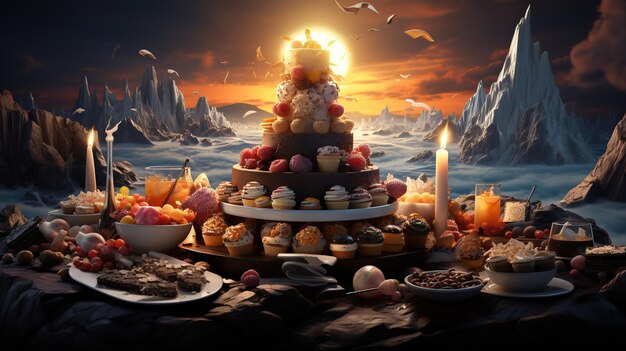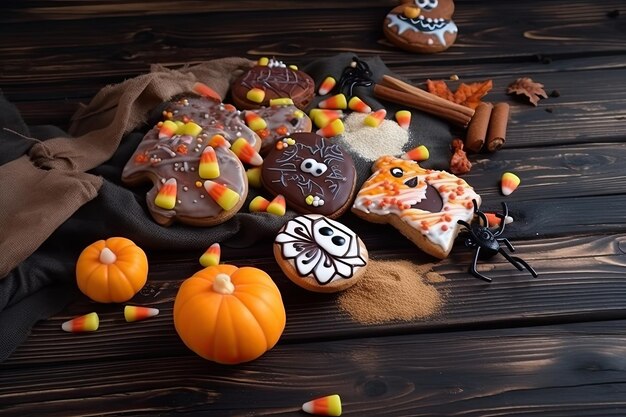Quick Read
The Sweet Tradition: Why Do We Eat Candy on Halloween and Its Historical Significance
Halloween, an ancient festival celebrated every year on October 31, is known for its spooky decorations, thrilling costumes, and scrumptious treats. Among these delightful traditions, none is as beloved as the giving and receiving of candy. But have you ever wondered why we indulge in this sweet custom? Let’s take a journey back in time to unravel the historical significance of this beloved Halloween tradition.
The Origins of Candy Giving
The origins of giving candy on Halloween can be traced back to the ancient Celtic festival of Samhain. During this time, people believed that the boundary between our world and the Otherworld became blurred, allowing ghosts, goblins, and other supernatural beings to roam the earth. To appease these spirits and ensure a prosperous harvest, the Celts would leave offerings of food and drink on their doorsteps.
A Sweet Evolution
Fast forward to the early Middle Ages, when the Christian feast of All Saints’ Day and All Souls’ Day (November 1 and 2) supplanted Samhain. The Church encouraged its followers to pray for the deceased, offering soul cakes as tokens of their devotion.
Soul Cakes: A Sweet Offering
Soul cakes were small, round loaves of bread that were sometimes flavored with raisins or currants. These cakes were often given to the poor, who would then pray for the souls of the donors and their families. Over time, these soul cakes evolved into sweet pastries, which became increasingly popular among children.
The Arrival of Candy
With the arrival of the industrial revolution, mass production made sweets more accessible and affordable. This led to an increase in their popularity, especially among children who went door-to-door asking for treats on Halloween. The term “trick or treat” first appeared in print in Canada in 1927, with children exchanging homemade fruit and nuts for treats like apples, popcorn balls, and yes, candy.
A Sweet Halloween Tradition
Today, the tradition of giving and receiving candy on Halloween continues to be a cherished part of our celebrations. Whether you’re a child dressing up in a costume or an adult handing out treats, there’s no denying the magic and joy that this sweet tradition brings.

Halloween: Unraveling the Rich History and Modern Traditions
Halloween, a night filled with ghouls, ghosts, and witches, is an exhilarating annual event celebrated primarily in the United States and Canada. The origins of this intriguing tradition can be traced back to ancient Celtic festivals, particularly Samhain. Samhain, celebrated around 1000 BCE, marked the end of the harvest season and the beginning of winter. It was believed that on this night, the boundary between the living world and the spirit world blurred, allowing the dead to rejoin their loved ones.
Celto-Christian Blend: Samhain and All Saints’ Day
As the Roman Empire expanded, many of its citizens adopted the Celtic beliefs and merged them with their own religious practices. In the 9th century CE, Pope Gregory III introduced All Saints’ Day, also known as Hallowmas or Hollowmas, on November 1st. All Saints’ Day was established to honor all the Christian saints and martyrs. The following day, All Souls’ Day, was added to remember and pray for the deceased.
Modern Halloween Traditions: A Sweet Connection to History
Fast forward to modern times, and the influence of both Samhain and All Saints’ Day on Halloween is quite apparent. The costumes, pumpkins, and jack-o’-lanterns are reminiscent of the Celtic belief in warding off evil spirits during Samhain. The practice of going door-to-door for treats, however, is a nod to the Christian tradition. During All Souls’ Day and All Saints’ Day, it was customary to leave treats like soul cakes on doorsteps for the poor or beggars who would pray for the deceased. This practice eventually morphed into trick-or-treating as we know it today, with children asking for candies instead of soul cakes.

The Evolution of Halloween Treats
Ancient Celtic offerings to the gods
The origins of Halloween treats can be traced back to ancient Celtic traditions, where people would make offerings to the gods as part of their Samhain festivities. These offerings typically included fruits, vegetables, nuts, and honey, symbolizing the bounty of the harvest. The round shape of many fruits, vegetables, and even loaves of bread represented the cycle of life itself.
European influences: Soul cakes and turnips
With the influence of Christianity, new traditions emerged. One such custom was the baking of soul cakes, small, round loaves given to beggars in exchange for their prayers for the dead. These soul cakes were often decorated with symbols like crosses and holy images. Another European influence was the use of turnips. Instead of soul cakes, people would sometimes carve turnips into jack-o’-lanterns and roast or eat them whole.
American influences: Apples, popcorn balls, and eventually candy
The arrival of America brought new traditions as well. One popular game during Halloween was apple bobbing, where participants would try to retrieve apples from a tub of water using only their teeth. In the early 20th century, popcorn balls became a safer alternative to apples due to concerns over choking hazards. Around the same time, the mass production and availability of candy made it an increasingly popular choice for Halloween treats.

I The Significance of Candy on Halloween
Symbolism of sweets as a reward:
The significance of candy on Halloween can be traced back to early traditions where sweets were used as a form of reward. In early European customs, people would offer soul cakes to the dead in exchange for their peaceful departure from the living world. The souls were believed to have traveled far and needed nourishment to continue their journey. Similarly, the Irish would make turnips into lanterns to ward off evil spirits and leave them out as offerings.
Early traditions: Soul cakes and turnips provided nourishment for the spirits
In modern times, however, candy has taken on a new role as a fun and sweet reward for children who go door-to-door trick-or-treating. The tradition allows kids to dress up in costumes, socialize with their peers, and collect treats from their neighbors.
Social and community aspects:
Trick-or-treating creates a sense of camaraderie between neighbors, families, and friends. Families prepare their homes with decorations and candles to welcome the trick-or-treaters. Neighbors engage in friendly competition to create the most impressive displays, while children enjoy the opportunity to socialize and build friendships.
Trick-or-treating creates a sense of camaraderie between neighbors, families, and friends
Moreover, sharing treats reinforces the importance of community connections. Trick-or-treaters often pool their candy together to make trades, creating opportunities for kids to learn the value of sharing and cooperation.
Cultural continuity:
The traditions surrounding candy on Halloween have persisted from ancient times to modern day, evolving as societies changed. Whether it’s offering soul cakes to the dead or collecting treats door-to-door, candy remains an integral part of the celebration.
Traditions have persisted from ancient times to modern day, evolving as societies change

Conclusion
As we reach the end of our journey through the history and significance of candy on Halloween, it’s essential to acknowledge the rich cultural traditions that have been passed down from generation to generation.
The roots of Halloween go back thousands of years, with ancient civilizations celebrating the harvest and the dead
. Over time, this celebration evolved into the festive occasion we know today.
One of the most cherished aspects of Halloween is the exchange of sweet treats. From apples and sugar cookies to chocolate bars and candy corn, these indulgences have become synonymous with the holiday.
Historically, candies were used as offerings to appease roaming spirits and ghosts
, ensuring a peaceful evening for the living.
Recap:
We’ve explored how ancient Celtic rituals and Christian festivities contributed to the development of Halloween as we know it today. The significance of costumes, jack-o’-lanterns, and sweet treats have all been highlighted throughout this narrative.
Importance of preserving traditions:
As our modern world continues to evolve, it’s essential that we cherish and preserve the customs that bring communities together.
Traditions like Halloween remind us of our shared human experiences
, providing a sense of connection and unity despite the differences that may exist between individuals.
Encouragement:
In the spirit of adaptation and continuity, we encourage families and communities to
embrace the love
that Halloween brings. Share stories of its history with children, engage in creative costume designs, and participate in local community events.
Let your creativity flow
when it comes to preparing homemade treats for trick-or-treaters or hosting a Halloween party. The possibilities are endless, allowing each family to put their unique spin on this cherished tradition.
Most importantly
, let us never forget the joy and connection that comes from sharing sweet treats with our loved ones. As we continue to celebrate Halloween, let’s ensure it remains a source of happiness and nostalgia for generations to come.


